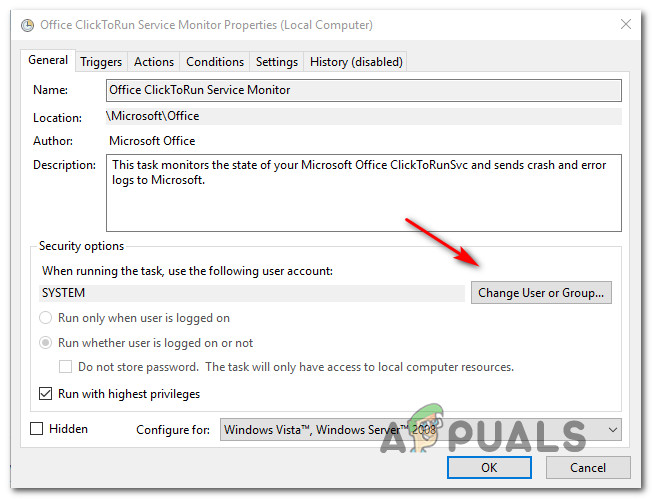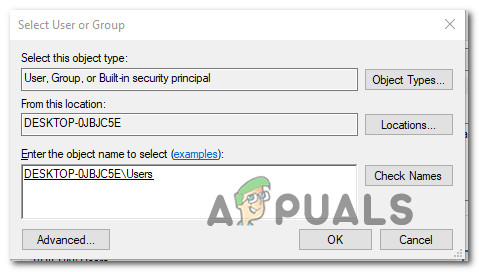How to Fix Task Scheduler Error Value 2147943726
Several users have been reaching us with questions after seeing the following error inside Event Viewer – Task Scheduler Error Value 2147943726. The majority of users are encountering this error when trying to run one or more tasks that were previously running without issues. The issue is not exclusive to a certain Windows version since it’s reported to occur on Windows 10, Windows 8.1 and Windows 7.

What is causing the Task Scheduler Error Value 2147943726 error?
We investigated this particular issue by looking at various user reports and the repair strategies that are commonly being used to fix this particular problem. As it turns out, there are a couple of different scenarios that have the potential of triggering this error message inside the Event Viewer:
- The issue is caused by a password change – In most cases, the issue is being caused by a change in the password for the user meant to run the scheduled task. If this scenario is applicable, you should be able to resolve the issue by configuring the task to stop the existing instance.
- The scheduled task is failing to start – This issue can also occur if the scheduled task has the correct password but doesn’t start due to a permission issue. In this case, you should be able to resolve the issue by re-assigning the user to an applicative account.
If you’re encountering the same error message, this article will provide you with several troubleshooting strategies that might end up resolving the issue. Down below, you’ll find several repair strategies that other users in a similar situation have successfully used to fix the Task Scheduler Error Value 2147943726 problem.
For the best results, we advise you to follow the methods in the order that they are presented since they are ordered by efficiency and severity. One of the methods below is bound to resolve the issue regardless of the culprit that ends up causing it.
Method 1: Re-assigning the User to an applicative account
The vast majority of users that have encountered this issue have reported that the issue was resolved after they re-assigned the User under (Change User or Group)to the latest Active directory information of the user.
If you want a long lasting solution, consider using an “applicative” user instead of a regular user which is subject to change more often on a regular basis. In the event that you use your account, it might end up changing your password every so often, which means that you will need to resort to applying this fix again.
But if you use an “applicative” account, chances are the fix you’ll do will last until the next Windows installation.
Here’s a quick guide on assigning an applicative account to the task that is triggering the error:
- Press Windows key + R to open up a Run dialog box. Then, type “taskschd.msc” and press Enter to open up the Task Scheduler utility.

Type taskschd.msc in the Run to open Task Scheduler - Inside your Task Scheduler, navigate to the task that is creating the issue, right-click on it and select Properties from the context menu.

Viewing the properties of the affected task - From the Properties screen of the affected task, select the General tab. Then, go to Security Options and click the Change User or Group button.

Changing the User or Group that is being used - Inside the Select User or Group window, type Users and click on Check Names to validate the applicative object name.
- Once the “Users” is changed to the correct address, click Ok to save the changes.

Modifying the default user - If you’re asked for your authentification credentials, provide them to complete the operation.
- Repeat the action that was previously triggering the error and see if the issue has been resolved.
If the issue is still not resolved, move down to the next method below.
Method 2: Configuring the task to stop the existing instance
If the issue is being caused by a change in the password (for the user that is supposed to run the scheduled task). The vast majority of users that encountered this problem have reported that they managed to resolve it by configuring the Task Scheduler to Stop the existing instance at the end of the cycle.
Here’s a quick guide on how to do this:
- Press Windows key + R to open up a Run dialog box. Then, type “taskschd.msc” and press Enter to open up the Task Scheduler utility.

Type taskschd.msc in the Run to open Task Scheduler - Inside your Task Scheduler, navigate to the task that is creating the issue, right-click on it and select Properties from the context menu.

Viewing the properties of the affected task - Inside the Properties screen of the task, go to the Settings tab and change the drop-down menu at the bottom of the screen to Stop the existing instance.

Changing task ending rule - Click OK, then repeat the action that was previously triggering the Task Scheduler Error Value 2147943726 and see if the issue has been resolved.





